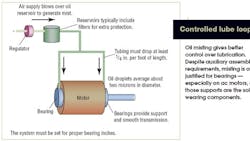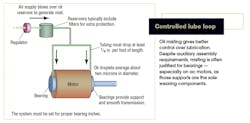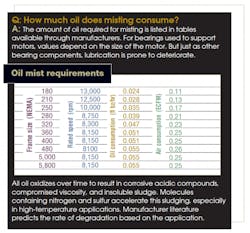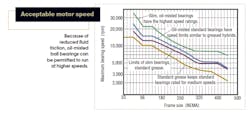Lubricant is an integral part of bearings. In critical applications where speeds run high, sometimes a constant spray of oil (or an oil-bath to the bottom rolling element middle) works better than a static grease lubricant.
Questions & Answers
Q: How much oil does misting consume?
A: The amount of oil required for misting is listed in tables available through manufacturers. For bearings used to support motors, values depend on the size of the motor. But just as other bearing components, lubrication is prone to deteriorate.
All oil oxidizes over time to result in corrosive acidic compounds, compromised viscosity, and insoluble sludge. Molecules containing nitrogen and sulfur accelerate this sludging, especially in high-temperature applications. Manufacturer literature predicts the rate of degradation based on the application.
Q: Why oil continuously?
A: Better control helps bring systems as close to optimal lubrication as possible. Oil misting provides very consistent hydrodynamic films and low friction losses to rolling elements. In dry-sump oil misting lubricant is exhausted from the bearing housing to prevent accumulation. In wet-sump oil misting a pool of oil collects in the bearing enclosure to oil the bearing should misting be interrupted. These systems provide good corrosion protection for two reasons: The formed oil film inhibits corrosion, and slightly elevated air pressure within the enclosure prevents entry of damaging corrosive elements and particulate foreign matter.
Q: Besides oxidation, are there other threats to watch out for?
A: Oil is also sheared apart by rubbing and sliding mechanical components. This is accelerated when additives altering viscosity are included. Fortunately, losses in lubricity are gradual, giving users time to correct and relubricate.
About the Author
Elisabeth Eitel
Elisabeth Eitel was a Senior Editor at Machine Design magazine until 2014. She has a B.S. in Mechanical Engineering from Fenn College at Cleveland State University.



